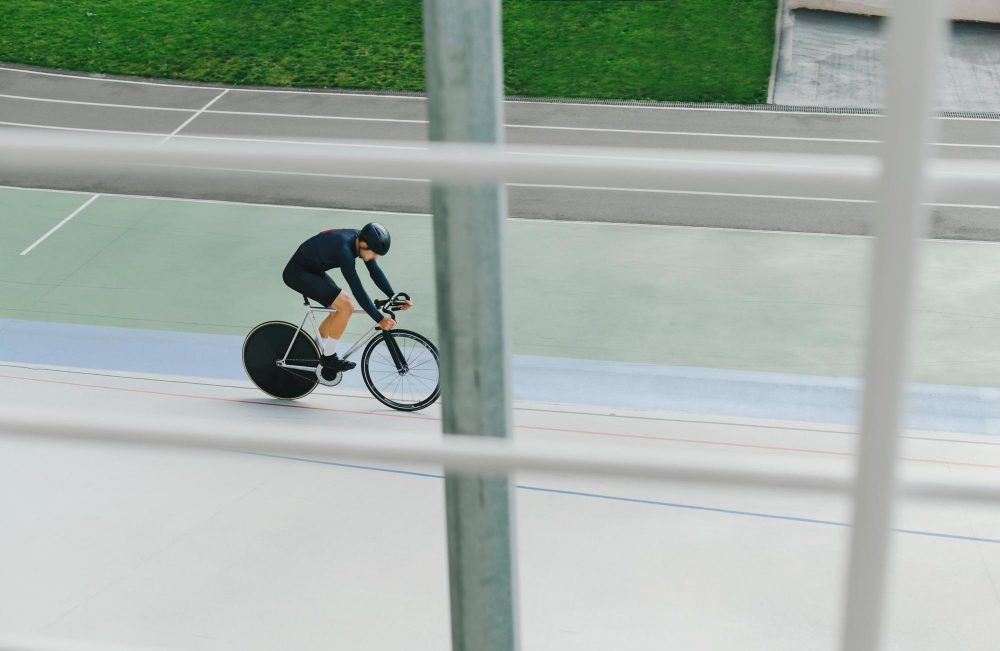How do you become a track cyclist?
Track cycling is an exhilarating and fast-paced sport that requires speed, endurance, and precise bike handling skills. If you’re inspired by the likes of Sir Chris Hoy or Laura Kenny and want to pursue a career as a track cyclist, this article will provide you with valuable insights on how to get started in this exciting discipline.
What is track cycling?
Track cycling takes place on a specialized indoor velodrome, which features steeply banked curves and a smooth wooden track. It involves various events, including sprint races, endurance races, and team pursuits. Track cyclists compete head-to-head or in teams, battling it out for victory while pushing their physical limits.
Training and Fitness
To become a successful track cyclist, rigorous training and fitness are essential. Building strength and stamina is crucial to handle the intensity of short sprint races or longer endurance events. You’ll need to work on developing explosive power in your legs and core stability to maintain balance at high speeds.
Strong aerobic fitness is also vital, as endurance events can be physically demanding. Regular cardio workouts, such as cycling or running, coupled with strength training exercises, will help you develop the necessary physical attributes to excel in track cycling.
Coaching and Mentorship
Seeking guidance from experienced coaches or mentors is invaluable when embarking on a track cycling journey. They can provide you with expert advice, personalized training plans, and technical feedback to enhance your skills. Joining a local cycling club or a track cycling-specific program can connect you with coaches who specialize in this discipline.
Bike Handling Skills
Mastering bike handling skills is critical for track cyclists, given the tight corners and close proximity to other riders during races. Practice on a velodrome, improving your ability to navigate turns at high speeds, change lines, and maintain stability while riding in a pack. Developing these skills will not only enhance your safety but also give you a competitive edge.
Competitions and Progression
Participating in track cycling competitions is essential for gaining experience and exposure. Start with local races to hone your skills and gradually progress to regional and national level events. It’s important to set realistic goals and focus on steadily improving your performance.
National Cycling Associations
To compete at higher levels, consider becoming a member of your country’s national cycling association. They offer structured pathways and talent development programs that can help you reach your potential as a track cyclist. These associations often have selection criteria for national teams and provide opportunities to participate in international competitions.
“Track cycling requires dedication, discipline, and a passion for speed. Embrace the challenges, keep pushing yourself, and never lose sight of your goals.”
How do track cyclists get big legs?
Track cycling is a highly demanding sport that requires athletes to generate immense power and speed. One of the distinguishing features of track cyclists is their impressive leg muscles. So, how do these athletes develop such big and powerful legs? Let’s dive into the strategies they employ.
1. Specific Training Regimens
Track cyclists follow rigorous training regimens that focus on building muscle strength and endurance. They engage in a combination of resistance training, plyometrics, and sprint-based workouts to target their leg muscles. These exercises help increase muscle size, improve explosive power, and enhance overall performance on the track.
2. High-Intensity Interval Training (HIIT)
HIIT workouts have gained popularity among track cyclists for their effectiveness in improving cardiovascular fitness and muscle development. This type of training involves short bursts of intense exercise followed by brief recovery periods. Not only does HIIT challenge the cardiovascular system, but it also stimulates muscle growth.
3. Proper Nutrition
Nutrition plays a vital role in muscle development. Track cyclists consume a diet high in protein to support muscle repair and growth. Foods like lean meats, poultry, fish, and legumes are excellent sources of protein. Additionally, a balanced diet rich in carbohydrates and healthy fats provides the necessary energy for intense training sessions.
4. Genetic Factors
While training and nutrition are crucial, genetic factors also contribute to the development of big legs in track cyclists. Some individuals naturally have a higher predisposition for muscle growth and strength. However, even with favorable genetics, consistent training and proper nutrition remain essential to maximize muscle development.
Track cycling is a sport that demands dedication, discipline, and hard work. By following specific training regimens, incorporating HIIT workouts, maintaining proper nutrition, and considering genetic factors, track cyclists can develop the impressive leg muscles needed for success on the track.
How do pro cyclists get so strong?
Professional cyclists are known for their exceptional strength and endurance, enabling them to tackle long and challenging races with ease. But how do they achieve such astonishing levels of fitness? Let’s dive into the training techniques and lifestyle choices that help pro cyclists build their strength and power.
1. Consistent Training
A key factor in a cyclist’s strength is consistent training. Pro cyclists follow rigorous training schedules that include a mix of endurance rides, interval training, hill repeats, and strength workouts. By consistently pushing their limits and gradually increasing their workload, they promote muscular adaptation and improve their overall strength.
2. Proper Nutrition
Pro cyclists understand the importance of proper nutrition to support their training and recovery. They focus on consuming a balanced diet that includes lean proteins, complex carbohydrates, healthy fats, and plenty of fruits and vegetables. This helps to provide the necessary nutrients for muscle repair and growth, as well as sustained energy during long rides.
3. Strength Training
While it may seem counterintuitive, pro cyclists also incorporate strength training into their routines. This helps to build muscular strength, stability, and power, which are crucial for generating more force during pedaling. Strength exercises such as squats, lunges, deadlifts, and core workouts contribute to overall cycling performance.
4. Interval Training
Interval training is another essential component of a pro cyclist’s training regimen. These high-intensity workouts involve alternating between periods of intense effort and recovery. This type of training improves cardiovascular fitness, increases lactate threshold, and enhances the body’s ability to tolerate high levels of fatigue, contributing to greater overall strength.
5. Mental Toughness
Besides physical training, mental toughness plays a crucial role in shaping a pro cyclist’s strength. Endurance races require immense mental fortitude to overcome fatigue and push through discomfort. Developing mental resilience through visualization techniques, positive self-talk, and goal-setting helps pro cyclists stay focused and perform at their best.
“Pro cyclists exemplify the dedication and discipline required to become strong athletes. Their training routines, nutrition choices, and mental toughness collectively contribute to their exceptional strength.”
By adopting the strategies used by professional cyclists, recreational riders can also improve their strength and performance on the bike. Remember to consult with a professional before starting any new training program to ensure it aligns with your individual goals and capabilities.
How Can I Increase My Sprint Speed Cycling?
Sprint speed is crucial in cycling, especially when it comes to competitive racing. Whether you’re a seasoned cyclist or just starting out, improving your sprint speed can boost your performance and give you an edge over your competitors. Here are some tips to help you increase your sprint speed:
1. Strength Training
Incorporating strength training exercises into your routine can help improve your power and explosiveness. Focus on exercises that target your lower body, such as squats, lunges, and leg presses. Additionally, incorporate upper body exercises like push-ups and pull-ups to maintain balance and stability.
2. Interval Training
Interval training involves alternating between high-intensity bursts of effort and periods of recovery. This type of training is ideal for improving your sprint speed. During your training rides, include sprint intervals where you pedal at maximum effort for a short period, followed by a recovery period. Repeat this cycle several times to build your sprinting capabilities.
3. Proper Technique
Developing proper sprinting technique can significantly enhance your speed. Focus on maintaining a smooth pedal stroke, with equal power on both upstrokes and downstrokes. Practice keeping your upper body relaxed and stable while driving force through your legs. By improving your technique, you can maximize your efficiency during sprints.
4. Mental Preparation
Aside from physical training, mental preparation plays a vital role in sprinting. Visualize yourself successfully sprinting and crossing the finish line triumphantly. Practice positive self-talk and set achievable goals to stay motivated throughout your training. Building mental resilience can help you push through challenging moments and give your all during sprints.
Remember, increasing sprint speed takes time and consistent effort. Be patient with yourself and celebrate small improvements along the way.
By incorporating these tips into your cycling routine, you can gradually improve your sprint speed and enhance your overall performance on the bike. Give them a try and enjoy the thrill of reaching new levels of speed and success!
How do I Increase my Sprint Power in Cycling?
Introduction
Cycling is a great way to stay fit and active, and if you’re looking to take your cycling game to the next level, improving your sprint power can make a significant difference. Whether you’re an experienced cyclist or just starting out, here are some effective strategies to help you increase your sprint power in cycling.
Strength Training
To improve your sprint power, incorporating strength training exercises into your routine is essential. Focusing on exercises that target your lower body, such as squats, lunges, and leg presses, can help build the muscles needed for explosive power during sprints. Additionally, including core and upper body exercises like planks and push-ups can provide a stable foundation for generating power.
Interval Training
Interval training involves alternating between periods of high-intensity effort and recovery, which can greatly enhance your sprint power. For example, incorporating interval sessions where you sprint for short bursts of time followed by a period of active recovery can train your body to deliver powerful bursts of speed. Gradually increase the duration and intensity of these intervals over time to continually challenge yourself.
Nutrition and Hydration
Proper nutrition and hydration play a crucial role in optimizing your sprint power. Make sure to fuel your body with a balanced diet that includes adequate carbohydrates, proteins, and healthy fats. Incorporating foods rich in nutrients, such as fruits, vegetables, and whole grains, can support your training efforts.
Rest and Recovery
Rest and recovery are often overlooked but are vital for increasing sprint power. Pushing yourself too hard without allowing time for recovery can lead to overtraining and a decline in performance. Make sure to incorporate rest days into your training schedule and prioritize sleep to allow your body to repair and adapt.
How do you train like a sprint cyclist?
Sprint cycling requires explosive power, immense strength, and impeccable technique. To train like a sprint cyclist, a combination of specific workouts and careful planning is essential. Here are some key training principles to help you enhance your sprint cycling performance:
Resistance Training
One crucial aspect of sprint cycling is building strength and power. Incorporate resistance training exercises such as squats, deadlifts, and leg presses into your workout routine. These exercises target the major muscle groups used during sprint cycling and improve your overall power output.
Sprint Intervals
Sprint intervals are a fundamental part of sprint training. During these sessions, you push yourself to maximum effort for a short duration, followed by a period of recovery. This helps improve your anaerobic capacity and ability to sustain high-octane efforts during races.
Technique and Form
Developing proper technique and form is crucial for sprint cycling. Focus on pedaling efficiency, body positioning, and bike handling skills. Work with a coach or join a cycling club to receive guidance on optimizing your technique.
Nutrition and Recovery
Proper nutrition and recovery play a vital role in maximizing your training gains. Fuel your body with a balanced diet that includes lean proteins, carbohydrates, and healthy fats. Adequate rest and sleep are equally important to allow your muscles to recover and grow stronger.
Remember, training like a sprint cyclist requires dedication, consistency, and perseverance. Stay motivated and keep pushing yourself towards your goals.
Here is an example of a sample sprint training week:
| Day | Workout |
|---|---|
| Monday | Sprint Intervals: 10 x 30-second all-out sprints with 2 minutes of recovery between each sprint. |
| Tuesday | Rest day or low-intensity endurance ride. |
| Wednesday | Resistance Training: Focus on lower body strength exercises such as squats and leg presses. |
| Thursday | Technique Practice: Work on sprint-specific drills and bike handling skills. |
| Friday | Active Recovery: Easy spin or light cross-training. |
| Saturday | Long Endurance Ride: Maintain a steady pace for an extended duration to build aerobic fitness. |
| Sunday | Rest day or active recovery. |
Remember, consistency is key in training like a sprint cyclist. Gradually increase the intensity and duration of your workouts while allowing ample time for recovery. With dedication and perseverance, you can improve your sprint cycling performance and reach new heights!
Conclusion
Improving your sprint power in cycling requires a combination of strength training, interval sessions, proper nutrition, and adequate rest. By following these strategies and staying consistent with your training, you will be on your way to increasing your sprint power and achieving your cycling goals.



